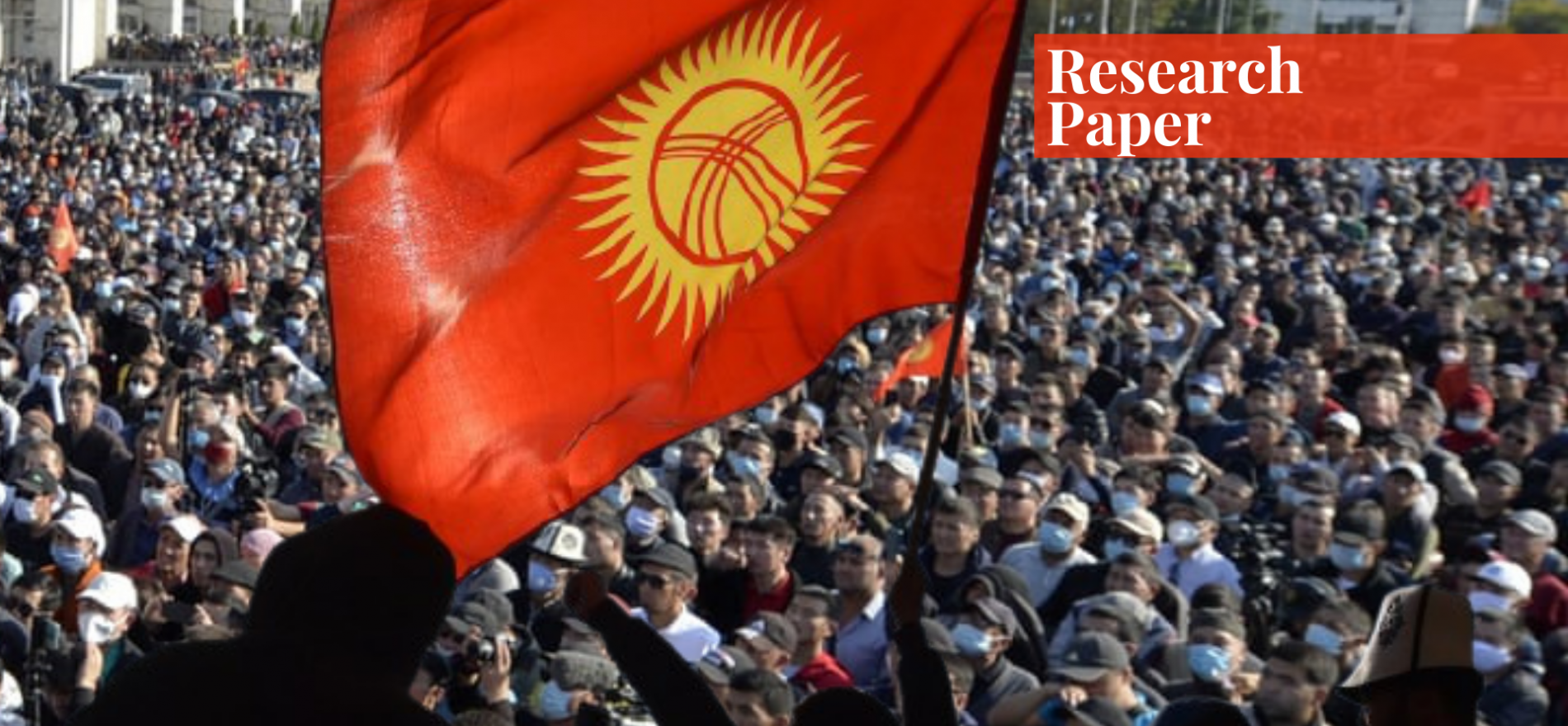Sadia holds a Bachelor in Social Sciences with a Major in International Relations from Bahria University, Islamabad. She has previously interned at various institutions in Pakistan, including the Institute of Rural Management (IRM) and Inter-Services Public Relations (ISPR). She is interested in writing and looks forward to publishing articles/research papers on global affairs.
Civil Societies in Kyrgyzstan
Civil society has continued to be a significant feature of the Kyrgyz Republic. The contrast between the previous unions and the present civil society organizations (CSOs) of Kyrgyzstan is that the former were solely concerned with their particular interests rather than being politically involved, but the current CSOs are politically intended and dynamic.
During Askar Akayev’s rule, the first president of Kyrgyzstan, the formation of International Organizations (IOs) and Non-Governmental Organizations (NGOs) was profoundly upheld at the underlying stages. These IOs and NGOs initiated various tasks that were vital for forming civil society within the country. In any case, it was likewise recognized by the worldwide network as an indication of successful democratization and establishment building.
Within the initial years of the republic, the NGOs and IOs that were set up went increasingly precarious and reliant on outside contributor associations for their subsidizing. Yet with the passage of time, these organizations became less reliant on foreign donor associations for their subsidizing and became more grounded. They additionally began examining strategic needs when compared with the benefits of the universal benefactor associations.
Origin and Growth of the Kyrgyz Civil Societies
One clarification of the robust and lively civil society in the Kyrgyz Republic is the ancient clan-based system inside the populace.1 They were initially nomads and that helped common society to develop exponentially. As of now, there is an expected number of 8000 to 12000 associations enlisted at the state level.2 They’re not only tasked with completing their vital goals but they also deeply affect societal and political areas of the nation.
With the passage of time, the function of CSOs and their political inclusion expanded and which had brought about two significant revolutions: the 2005 Tulip Revolution and the Kyrgyz Revolution of 2010. CSOs are vital for this country because the government of Kyrgyzstan is usually authoritative or, in different words, partly-democratic.
These CSOs are additionally subdivided into two types. The first are those that are involved with the state’s economic and societal affairs and, for the most part, work at the local level. The others are associated with the political reforms and democratization at the administration level. They are progressively worried about the legislative issues and the organizations of the state.
Initially, the ascent of NGOs and CSOs was strengthened by the government, but when they began affecting political affairs, they were unequivocally denounced. The purpose for this is basically on the grounds that the administration belittled the effect of CSO’s and attempted to utilize them to legitimize their standard since it generally had dictator inclinations although chose democratically.
The 2005 Tulip Revolution
In March 2005, noteworthy changes occurred in the legislative framework of Kyrgyzstan, typically recognized as the “Tulip Revolution” which occurred before the end of Askar Akayev’s era. Askar Akayev was receptive to democratic values and was viewed as the liberal pioneer among the entirety of the Commonwealth of Independent States (CIS).
He was a robust proponent of CSOs initially; however, later he began constraining monetary and political autonomy with his tyrant rule. The aim of Akayev’s rule was to cut the effect of the civil societies by utilizing assets of the state, state-governed media, and NGOs supported by his legislature.
In the elections of 2003, Akayev enhanced his presidential powers and command. The opposition was suppressed by purchasing writers and by utilizing state-governed media. The Tulip Revolution was a consequence of the government’s misuse of the civil society associations for its very own advantages.
The impact of government-subsidized NGOs was that there was a transparent difference of views among the overall population due to the endeavors done by IO’s and CSO’s which were balanced by government bolstered associations.3 The administration-run NGOs usually blamed different valid associations such as the civil society for obtaining external financing despite the fact that they were subsidized by World Bank.4
The Kyrgyz Revolution of 2010
In 2010, another revolution eventuated in Kyrgyzstan due to nepotism, pay inconsistencies, and privatization strategies of the legislature. Kurmanbek Bakiyev, the successor of Askar Akayev, failed to fulfill his promises to the public. As it failed to maintain a solid financial base, the administration obtained funding from worldwide associations, and therefore the leaders of these associations were engaged in creating appropriate strategies for their inclinations.
The Russian-supported gatherings against the Bakiyev rule was another factor for this revolution. The powerful political culture of Kyrgyzstan was the result of these two revolutions. In the beginning of independence, the state had presented a culture of political pluralism and dissent, but since the country was turning out to be increasingly definitive and corrupt, the extent for political pluralism was reducing due to which riots occurred within Osh and Jalalabad, with genocides of ethnic Kyrgyz and Uzbeks.
Present Civil Society of Kyrgyzstan
The 2010 revolution had a noteworthy impact on the functioning of CSOs throughout the state. In 2010, the change in the political framework was due to the growth of the civil society sector in the country, giving IOs and NGOs the autonomy to scrutinize the government for their inappropriate exercises and authoritative methods.
In 2014, the Kyrgyz parliament attempted to block the actions of NGOs and CSOs. Nevertheless, the civil society worked effectively against this enactment by utilizing various gatherings and succeeded. Kyrgyz civil society associations assumed a functioning job in bringing awareness to individuals on the enactment, which also shows how profoundly established CSOs are in Kyrgyzstan.
However, the greatest test with CSOs is their financing for which they are subject to outside contributor associations like the UN and USAID. The administration has now taken up the duty of financing these NGOs and CSOs through an agreement to evade any sort of outside subsidizing.5 However, the administration is unable to grant funds due to the financial situation of the country.
In 2016, the administration passed an enactment whereby CSOs were recognized as welfare associations, with the goal to give them financial assistance so that they wouldn’t rely on outside donor associations for their financing.
In 2017 and 2018, CSOs were again blamed for operating under the veil for humanitarian endeavors by the administration, and recently the legislature has attempted to create obstacles for tranquil opposition by general society for truthful elections.
Conclusion
Before the autonomy of Kyrgyzstan, civil society had its profound essence. In the Soviet times, it was available in the political framework of Kyrgyzstan but after freedom, CSOs obtained a favorable condition for their development both by the recent government and by the worldwide network including universal donor associations.
Later, the Kyrgyz government consistently held authoritative inclinations and controlled the functioning of the CSOs for its own advantages. A significant number of the CSOs were attempting to activate individuals against the administration, while a few were dealing with the administration’s plan of attempting to neutralize the effect of other associations.
Even after the revolutions of 2005 and 2010, the government of Kyrgyzstan attempted to confine the impact of these associations, and yet their influence was not able to be precluded. Alongside the weak economy, Kyrgyzstan also has a weak political framework with the administering party and legislators being heavily engrossed in unlawful acts.
The administration has thus attempted to impact the functioning of the CSOs by holding them responsible for obtaining subsidies from outside powers and working for their incentives. In the present time, civil society organizations have developed themselves into proficient arrangements. The civil society in Kyrgyzstan is additionally working with global organizations such as the World Bank, the UN, and USAID.
Endnotes
1 Anvar Bugazov, “Socio-Cultural Characteristics of Civil Society Formation in Kyrgyzstan,” Central Asia-Caucasus Institute & Silk Road Studies Program, 2013. https://www.silkroadstudies.org/resources/pdf/SilkRoadPapers/2013_07_SRP_Bugazov_Civil-Society-Kyrgyzstan.pdf.
2 Ann Kathrin Rothermel, “Civil Society Conceptions in the Kyrgyz Republic,” Otto-Suhr-Institut Für Politikwissenschaft, July 22, 2014. https://archiv.iep-berlin.de/wp-content/uploads/2014/10/Paper_Rothermel.pdf?it=wp-content/uploads/2014/10/Paper_Rothermel.pdf.
3 Mathijs Pelkmans, “On Transition and Revolution in Kyrgyzstan,” Focaal – Journal of Global and Historical Anthropology, no. 46, 2005. https://eprints.lse.ac.uk/28062/1/Pelkmans_Transition_revolution_Kyrgyzstan_2005.pdf.
4 Pelkmans, “On Transition and Revolution,”.
5 Chiara Pierobon, “The Development of Civil Society in Post-Soviet Kyrgyzstan: An Analysis of the National and International Context,” Annali Di Ca’ Foscari. Serie Orientale 54(1), June 2018. https://www.researchgate.net/publication/325943131_The_Development_of_Civil_Society_in_Post-Soviet_Kyrgyzstan_An_Analysis_of_the_National_and_International_Context.
Bibliography
- Bialeva, C. Political and Civil Society Report for Kyrgyzstan, February 2004. Bishkek: INTRAC.
- Bugazov, Anvar. 2013. “Socio-Cultural Characteristics of Civil Society Formation in Kyrgyzstan.” Central Asia-Caucasus Institute & Silk Road Studies Program. https://www.silkroadstudies.org/resources/pdf/SilkRoadPapers/2013_07_SRP_Bugazov_Civil-Society-Kyrgyzstan.pdf.
- Pelkmans, Mathijs. 2005. “On transition and revolution in Kyrgyzstan.” Focaal – Journal of Global and Historical Anthropology, no. 46. https://eprints.lse.ac.uk/28062/1/Pelkmans_Transition_revolution_Kyrgyzstan_2005.pdf.
- Pierobon, Chiara. 2018. “The Development of Civil Society in Post-Soviet Kyrgyzstan: An Analysis of the National and International Context.” Annali di Ca’ Foscari. Serie orientale 54(1). https://www.researchgate.net/publication/325943131_The_Development_of_Civil_Society_in_Post-Soviet_Kyrgyzstan_An_Analysis_of_the_National_and_International_Context.
- Rothermel, Ann-Kathrin. 2014. “Civil Society conceptions in the Kyrgyz Republic.” Otto-Suhr-Institut für Politikwissenschaft. https://archiv.iep-berlin.de/wp-content/uploads/2014/10/Paper_Rothermel.pdf?it=wp-content/uploads/2014/10/Paper_Rothermel.pdf.
If you want to submit your articles and/or research papers, please check the Submissions page.
The views and opinions expressed in this article/paper are the author’s own and do not necessarily reflect the editorial position of Paradigm Shift.



















